We deliver the voice in the mobile network: step 1 - how the voice turns into an electrical signal
We all use mobile communications, and do not think about how difficult the path our voice has to go in order to be heard by the interlocutor is hundreds and thousands of kilometers away. A huge amount of tasks is carried out by the simplest handset, even when you wait for a call (when it lies on your desk), and inevitably you get respect for those who developed all this first in theory and then embodied in real equipment.
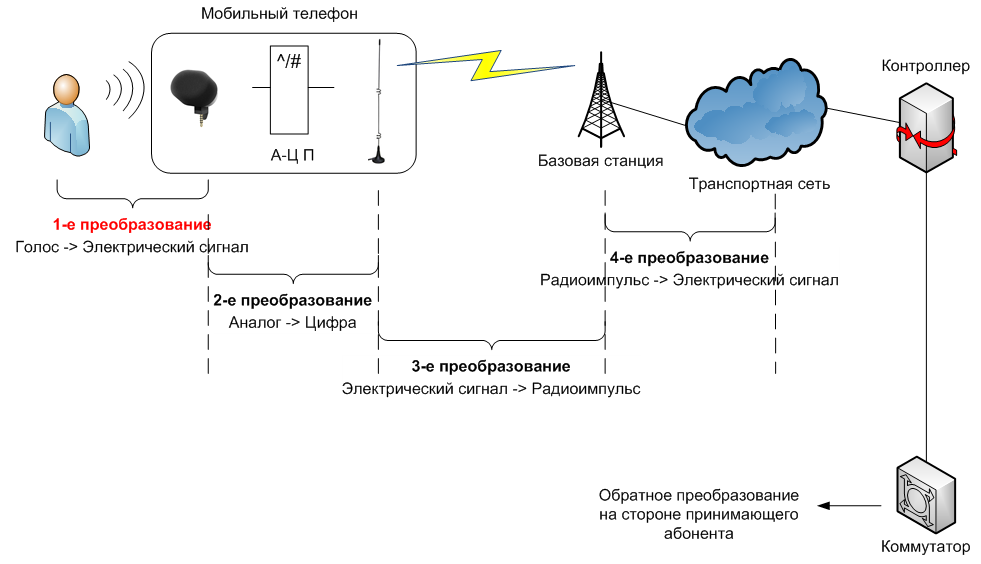
Behind the usual actions: pick up a phone, dial a number, and hear a voice in the receiver, there are so many technical details, fundamental discoveries and technological transformations that we need to break down the description into several stages, and consider each of them separately.

It all started simply .
The first thing that comes to mind when we try to communicate at a great distance is to increase the volume of the sound source, for example, using the speaker as in the figure above, and the sensitivity of the receiver:
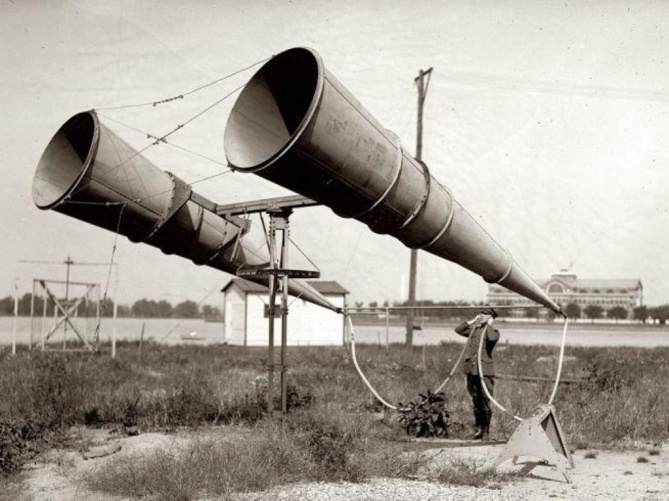
However, if you need to transmit sound between rooms, the horns become useless, and an inquiring engineering mind developed options for "air ducts" through which you can send a message from one point to another.
For example, intercoms, which can still be found on large ships:


All these tricks, allow you to transmit sound vibrations (of which our speech actually consists), over slightly greater distances than nature intended. But we need to ensure voice transmission over an almost unlimited distance, through any obstacles!
So the idea appears not to transmit the original sound waves, but to conduct an intermediate conversion to another transmission medium, which will save the necessary information without losing data, and will allow you to restore it on the receiving side. As an intermediate medium, various materials or physical phenomena can be used.
In childhood, probably, many were engaged in the manufacture of “phones” from improvised means, for example, a pair of boxes and an ordinary thread:

Despite the simplicity of the solution, the sound from one box, through the elastic vibrations of the thread, is perfectly transmitted to the second, where it can be clearly heard. However, the minuses in this solution are much more advantages: to transmit elastic vibrations from the box along the thread, you need to pull the thread and ensure that it does not touch anything; the maximum distance that voice can be transmitted using such elastic vibrations is only tens of meters, etc. All this excludes the possibility of using this, and similar transformations, as a real intercom.
The search for voice transmission options described above leads us to the need to choose a suitable intermediate medium, and methods for the qualitative conversion of sound vibrations into the parameters of a new medium and vice versa. Of the variety of physical phenomena and materials, an electrical signal is best suited to these requirements, and here, finally, we can begin the description of the first conversion, which is carried out in modern wireless networks:

To perform the conversion “Sound vibrations - Electric signal”, a device called a “Microphone” is used, from the Greek micro - small, background - sound.
Let's try to describe the main milestones in the development of technology for converting sound into an electrical signal.
1. Alexander Bell's liquid transmitter
It is believed that it was with him that the development of sound-to-electric converters began. Alexander Bell conducted experiments in 1876, and even managed to convey his voice over the wire, over a short distance.

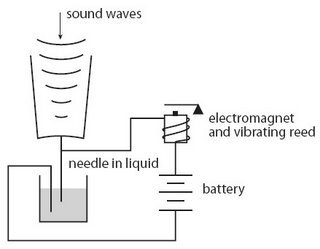
It was necessary to speak into the horn located at the top, a thin needle (or wire) was attached to the lower part of the diaphragm mounted on the horn, and moved under the influence of sound vibrations. In the lower tank was a solution of water with a small amount of acid (to improve electrical conductivity), the needle, when moving with the diaphragm, was more or less immersed in the liquid, and the resistance of the system changed, which was monitored on a device with a coil and a magnet.
The disadvantages of the solution are visible to the naked eye - a bulky device, the presence of liquids, low conversion accuracy. All this did not allow the use of an experimental device for commercial projects, but the beginning was laid.
An inquisitive reader may try to reproduce such a device, for example, according to the recommendations from this site:Step-by-step recommendations for manufacturing the “Bell fluid transmitter”
2. David Hughes carbon (rod) microphone
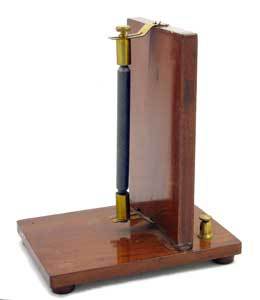
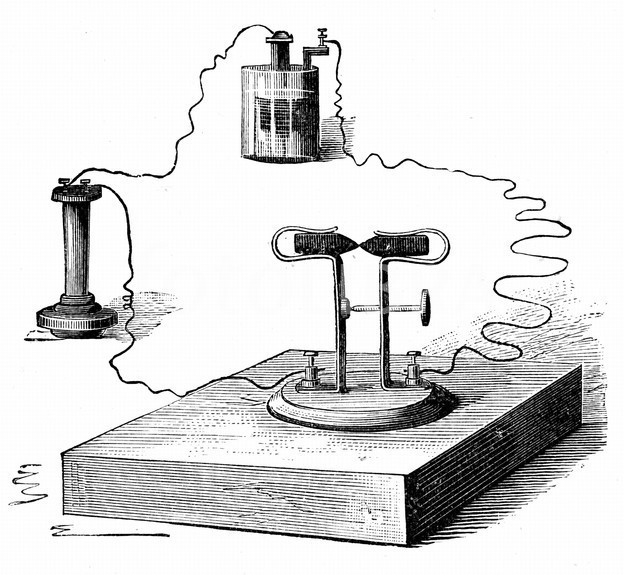
Several years later, David Hughes introduced another version of the microphone in which a carbon rod was used as a sound-to-electric converter. Under the influence of sound vibrations, the contact area of the coal rod with the metal pad was changed, and the resistance of the rod was proportionally changed. This device has already been used for practical purposes, for real voice transmission. But the era was coming of an advanced carbon-based solution (the same coal that Hughes used in his core).
3. Edison's carbon (powder) microphone
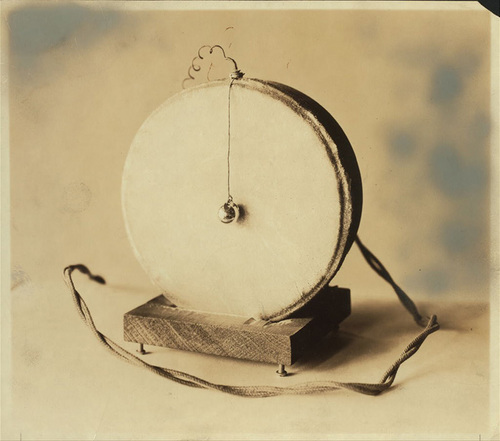

The superiority in the development of this microphone was disputed for a long time, between the American engineers Bell, Berliner and Edison, there is also evidence that the Russian engineer Mikhalsky, at about the same time, made a similar device.
According to the generally accepted version, Edison is considered the inventor, and Bell's laboratory is the main developer and popularizer (which bought Berliner's early patent and hired the inventor, but then Edison proved his superiority in court). The principle of operation of this microphone is based on the fact that coal, crushed into a fine powder, changes the electrical resistance, depending on its density. Thus, the membrane under the influence of sound waves changes the density of the coal powder, which leads to a change in the characteristics of the electric current passing through it. The microphone turned out to be so successful that it was used from the end of the 19th century until the beginning of the 21st, in devices where analog voice transmission is used (we will talk about Digital-Analog Conversions in the next part).
4. Dynamic and condenser microphones.
Further development of technology led to the development of condenser and dynamic microphones, around the 20-30s of the 20th century. In a condenser microphone, a change in the parameters of the electric current occurs due to a change in the capacitance of the capacitor, one of the conductive plates of which is made in the form of a membrane moving under the influence of sound waves.


A dynamic microphone consists of a fixed magnet, and a winding that moves along with the membrane, thus creating an electric current.
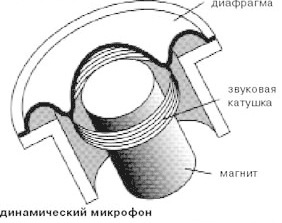
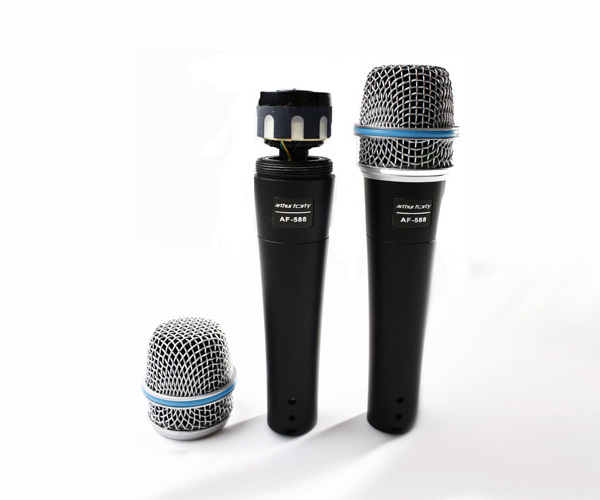
Both types of microphones have their advantages and disadvantages, and now both condenser and dynamic designs are used. These microphones allow you to catch such frequencies of sound vibrations that are inaccessible to the human ear, therefore, for our purposes - converting voice into an electrical signal, their capabilities are more than enough. It is only necessary to fit this design into the housing of a mobile phone. To do this, the engineers had a little more smash their heads.
5. Electret microphones
The main requirement for microphones for use as part of a cell phone is the minimum size and acceptable conversion quality. For such purposes, one of the options for a condenser microphone was best suited: an electret microphone. In it, one lining is made of electret material, which is able to maintain a polarized state for a long time, after removing external influences.
The first models of electret microphones were in the form of capsules, and could already be used in the handsets of cell phones:

Microelectromechanical systems - MEMS and surface mounting - SMD
Further miniaturization leads us to a new class of components - MEMS, where mechanical and electronic devices are combined on one printed circuit board. Later, with the advent and development of surface technology for printed circuit boards (SMD), miniaturization of microphones reached maximum values, and finally we can fit our microphone in a phone less than 10 mm thick.
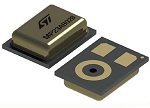
So, thanks to technological progress and engineering, we have a miniature and high-quality device that converts sound vibrations into an electrical signal:

This is only the first transformation of our voice in the process of transmitting it through a cellular network, and each next step will require increasingly sophisticated technical devices and an advanced mathematical apparatus. The next part is the necessary transformations of the received electrical signal, still inside the telephone, in order to prepare it for transmission on the air, with brief historical excursions - how our understanding of these processes developed.

Behind the usual actions: pick up a phone, dial a number, and hear a voice in the receiver, there are so many technical details, fundamental discoveries and technological transformations that we need to break down the description into several stages, and consider each of them separately.

It all started simply .
The first thing that comes to mind when we try to communicate at a great distance is to increase the volume of the sound source, for example, using the speaker as in the figure above, and the sensitivity of the receiver:

However, if you need to transmit sound between rooms, the horns become useless, and an inquiring engineering mind developed options for "air ducts" through which you can send a message from one point to another.
For example, intercoms, which can still be found on large ships:


All these tricks, allow you to transmit sound vibrations (of which our speech actually consists), over slightly greater distances than nature intended. But we need to ensure voice transmission over an almost unlimited distance, through any obstacles!
So the idea appears not to transmit the original sound waves, but to conduct an intermediate conversion to another transmission medium, which will save the necessary information without losing data, and will allow you to restore it on the receiving side. As an intermediate medium, various materials or physical phenomena can be used.
In childhood, probably, many were engaged in the manufacture of “phones” from improvised means, for example, a pair of boxes and an ordinary thread:

Despite the simplicity of the solution, the sound from one box, through the elastic vibrations of the thread, is perfectly transmitted to the second, where it can be clearly heard. However, the minuses in this solution are much more advantages: to transmit elastic vibrations from the box along the thread, you need to pull the thread and ensure that it does not touch anything; the maximum distance that voice can be transmitted using such elastic vibrations is only tens of meters, etc. All this excludes the possibility of using this, and similar transformations, as a real intercom.
The search for voice transmission options described above leads us to the need to choose a suitable intermediate medium, and methods for the qualitative conversion of sound vibrations into the parameters of a new medium and vice versa. Of the variety of physical phenomena and materials, an electrical signal is best suited to these requirements, and here, finally, we can begin the description of the first conversion, which is carried out in modern wireless networks:
First conversion: Voice - Electrical signal

To perform the conversion “Sound vibrations - Electric signal”, a device called a “Microphone” is used, from the Greek micro - small, background - sound.
Let's try to describe the main milestones in the development of technology for converting sound into an electrical signal.
1. Alexander Bell's liquid transmitter
It is believed that it was with him that the development of sound-to-electric converters began. Alexander Bell conducted experiments in 1876, and even managed to convey his voice over the wire, over a short distance.


It was necessary to speak into the horn located at the top, a thin needle (or wire) was attached to the lower part of the diaphragm mounted on the horn, and moved under the influence of sound vibrations. In the lower tank was a solution of water with a small amount of acid (to improve electrical conductivity), the needle, when moving with the diaphragm, was more or less immersed in the liquid, and the resistance of the system changed, which was monitored on a device with a coil and a magnet.
The disadvantages of the solution are visible to the naked eye - a bulky device, the presence of liquids, low conversion accuracy. All this did not allow the use of an experimental device for commercial projects, but the beginning was laid.
An inquisitive reader may try to reproduce such a device, for example, according to the recommendations from this site:Step-by-step recommendations for manufacturing the “Bell fluid transmitter”
2. David Hughes carbon (rod) microphone


Several years later, David Hughes introduced another version of the microphone in which a carbon rod was used as a sound-to-electric converter. Under the influence of sound vibrations, the contact area of the coal rod with the metal pad was changed, and the resistance of the rod was proportionally changed. This device has already been used for practical purposes, for real voice transmission. But the era was coming of an advanced carbon-based solution (the same coal that Hughes used in his core).
3. Edison's carbon (powder) microphone


The superiority in the development of this microphone was disputed for a long time, between the American engineers Bell, Berliner and Edison, there is also evidence that the Russian engineer Mikhalsky, at about the same time, made a similar device.
According to the generally accepted version, Edison is considered the inventor, and Bell's laboratory is the main developer and popularizer (which bought Berliner's early patent and hired the inventor, but then Edison proved his superiority in court). The principle of operation of this microphone is based on the fact that coal, crushed into a fine powder, changes the electrical resistance, depending on its density. Thus, the membrane under the influence of sound waves changes the density of the coal powder, which leads to a change in the characteristics of the electric current passing through it. The microphone turned out to be so successful that it was used from the end of the 19th century until the beginning of the 21st, in devices where analog voice transmission is used (we will talk about Digital-Analog Conversions in the next part).
4. Dynamic and condenser microphones.
Further development of technology led to the development of condenser and dynamic microphones, around the 20-30s of the 20th century. In a condenser microphone, a change in the parameters of the electric current occurs due to a change in the capacitance of the capacitor, one of the conductive plates of which is made in the form of a membrane moving under the influence of sound waves.


A dynamic microphone consists of a fixed magnet, and a winding that moves along with the membrane, thus creating an electric current.


Both types of microphones have their advantages and disadvantages, and now both condenser and dynamic designs are used. These microphones allow you to catch such frequencies of sound vibrations that are inaccessible to the human ear, therefore, for our purposes - converting voice into an electrical signal, their capabilities are more than enough. It is only necessary to fit this design into the housing of a mobile phone. To do this, the engineers had a little more smash their heads.
5. Electret microphones
The main requirement for microphones for use as part of a cell phone is the minimum size and acceptable conversion quality. For such purposes, one of the options for a condenser microphone was best suited: an electret microphone. In it, one lining is made of electret material, which is able to maintain a polarized state for a long time, after removing external influences.
The first models of electret microphones were in the form of capsules, and could already be used in the handsets of cell phones:

Microelectromechanical systems - MEMS and surface mounting - SMD
Further miniaturization leads us to a new class of components - MEMS, where mechanical and electronic devices are combined on one printed circuit board. Later, with the advent and development of surface technology for printed circuit boards (SMD), miniaturization of microphones reached maximum values, and finally we can fit our microphone in a phone less than 10 mm thick.

So, thanks to technological progress and engineering, we have a miniature and high-quality device that converts sound vibrations into an electrical signal:

This is only the first transformation of our voice in the process of transmitting it through a cellular network, and each next step will require increasingly sophisticated technical devices and an advanced mathematical apparatus. The next part is the necessary transformations of the received electrical signal, still inside the telephone, in order to prepare it for transmission on the air, with brief historical excursions - how our understanding of these processes developed.
